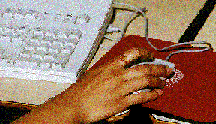
CL: What do you mean by technology that is "more significant than just computers"?
These new areas of scientific investigation are being invented as we speak, and my concern is that artists have an opportunity to play a role in that evolution. They shouldn't come to it late as they did with computers -- after big business, the military and the government had already thoroughly entrenched themselves. Artists can assist and influence the direction of the applications to which these technologies are dedicated.
SLAYTON: We understand computers, how they work and what they can do now. But
CL: The idea that an artist could work with genetics seems outrageous because industry wants to keep it under their control?
SLAYTON:It's hard to know what industry wants to do
SLAYTON: Molecular-sized machines... like for cryonic suspension, for thawing frozen bodies out, you set these little machines loose to go in and repair damaged tissue. It's not just an idea, they've been working pretty desperately on dealing with frostbite and have made significant progress. Other practical uses would be to have these little molecular gadgets gobble up an oil spill, digest it and release a non-toxic by-product. Or you could inject them into your bloodstream to clean up your arteries, or use toothpaste that know your teeth. The idea behind nano-technology is that you have a bunch of minute machines that can work together to build other more complex machines.
SLAYTON: I think it will grow relative to the direction that the culture takes, and the direction that technology takes